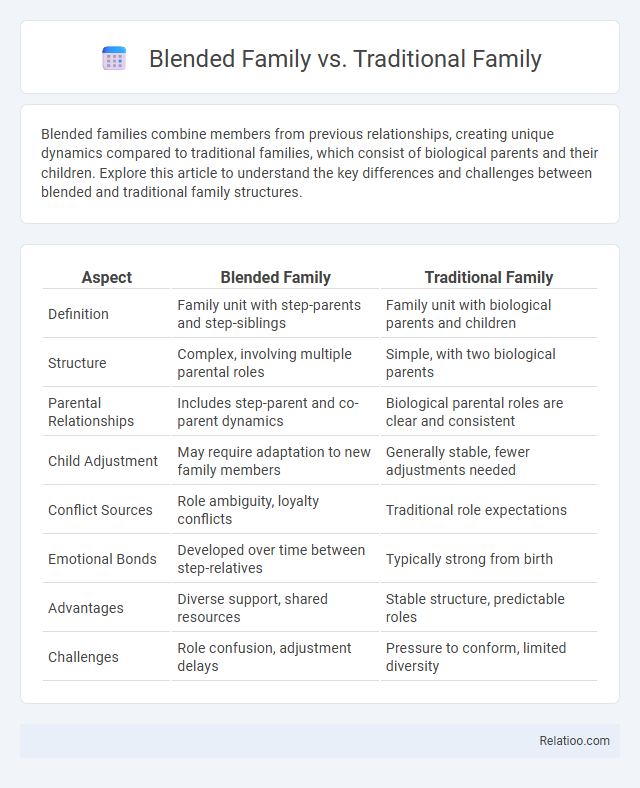Blended families combine members from previous relationships, creating unique dynamics compared to traditional families, which consist of biological parents and their children. Explore this article to understand the key differences and challenges between blended and traditional family structures.
Table of Comparison
| Aspect | Blended Family | Traditional Family |
|---|---|---|
| Definition | Family unit with step-parents and step-siblings | Family unit with biological parents and children |
| Structure | Complex, involving multiple parental roles | Simple, with two biological parents |
| Parental Relationships | Includes step-parent and co-parent dynamics | Biological parental roles are clear and consistent |
| Child Adjustment | May require adaptation to new family members | Generally stable, fewer adjustments needed |
| Conflict Sources | Role ambiguity, loyalty conflicts | Traditional role expectations |
| Emotional Bonds | Developed over time between step-relatives | Typically strong from birth |
| Advantages | Diverse support, shared resources | Stable structure, predictable roles |
| Challenges | Role confusion, adjustment delays | Pressure to conform, limited diversity |
Introduction to Family Structures
Blended families consist of partners and children from previous relationships, creating a unique dynamic different from traditional families, which typically include two biological parents and their children. Stepfamilies form when one partner has children from a previous relationship, requiring adjustments in roles and relationships. Understanding your family structure helps navigate expectations and strengthens connections within diverse household environments.
Defining Blended Families
Blended families consist of members from previous relationships, combining children and adults into a new family unit, which differs from traditional families that typically involve biological parents and their children. Stepfamilies are a subset of blended families formed when one or both partners bring children from prior relationships into a new marriage or partnership. Understanding blended families is crucial for addressing your unique challenges and fostering harmonious relationships within these complex family dynamics.
Understanding Traditional Families
Traditional families consist of two biological parents and their children living together in one household, often characterized by stable, long-term relationships and clear parental roles. Your understanding of traditional families highlights strong generational bonds, predictable family dynamics, and cultural continuity, which can differ significantly from the complexities seen in blended or stepfamilies. These distinctions influence emotional support systems, caregiving responsibilities, and adaptability to family changes.
Key Differences Between Blended and Traditional Families
Blended families consist of partners and their children from previous relationships, while traditional families typically include two biological parents and their children living together. Key differences between blended and traditional families include complex family dynamics, such as navigating relationships among step-siblings and step-parents, and varied parenting roles compared to the more uniform structure in traditional families. Emotional challenges and the need for strong communication strategies are often more pronounced in blended families due to these unique relational dynamics.
Benefits of Blended Families
Blended families offer unique benefits by combining diverse perspectives and experiences from both partners' previous relationships, fostering greater empathy and resilience among family members. These families often develop strong communication skills and adaptability, which contribute to healthy emotional support systems for children and adults alike. Compared to traditional and stepfamilies, blended families provide enriched social networks and shared resources, enhancing overall family stability and well-being.
Challenges Faced by Blended Families
Blended families often encounter unique challenges such as navigating complex relationships between stepparents, biological parents, and children, which can lead to loyalty conflicts and communication barriers. Unlike traditional families with established roles or stepfamilies formed through remarriage, blended families must develop new family dynamics while addressing differing parenting styles and past emotional baggage. Managing expectations and fostering trust are critical for success in blended families, where adaptability and patience are essential to overcoming integration difficulties.
Advantages of Traditional Families
Traditional families often benefit from established roles and long-term stability, which can provide a strong foundation for emotional support and consistent parenting. This family structure typically offers clear generational ties and shared cultural or familial traditions, fostering a sense of identity and belonging. The predictability in traditional families can enhance communication and reduce conflicts compared to blended or stepfamilies where complexities and adjustment periods are more common.
Modern Social Perceptions
Modern social perceptions of blended families emphasize their adaptability and diversity compared to traditional families, which are often viewed as the conventional nuclear unit composed of two married biological parents and their children. Stepfamilies, a subset of blended families, face unique challenges with role expectations and relationship dynamics but are increasingly recognized for their potential to foster strong bonds and resilience. Research indicates a growing societal acceptance of these family structures, highlighting their prevalence in contemporary demographics and the emphasis on emotional support over strict biological ties.
Impact on Children’s Well-Being
Blended families, traditional families, and stepfamilies each uniquely impact children's well-being by influencing stability, emotional security, and social relationships. Children in traditional families often benefit from consistent routines and parental roles, while those in blended and stepfamilies may face challenges adjusting to new family dynamics, potentially affecting their emotional health. Your support and open communication can foster resilience and positive outcomes for children navigating the complexities of blended or stepfamily environments.
Choosing the Right Family Structure
Choosing the right family structure depends on individual values, needs, and circumstances, with blended families combining members from previous relationships to create a unified household, offering flexibility and diverse dynamics. Traditional families, typically consisting of two biological parents and their children, provide stability and rooted cultural norms that prioritize continuity and shared upbringing. Stepfamilies involve one or both partners bringing children from prior relationships, requiring clear communication and role definition to foster harmony and effective co-parenting.

Infographic: Blended Family vs Traditional Family
 relatioo.com
relatioo.com